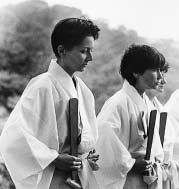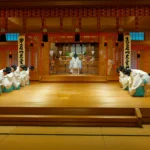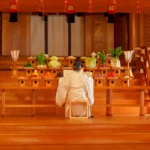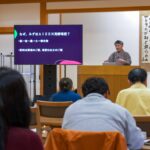
The Reunion Seminar, 1992 An Introduction to Shinto
Since its founding in 1976, the Oomoto School of Traditional Japanese Arts strived always to keep the religious elements of Oomoto and Shinto separate from the teaching of the arts. This is part of Oomoto’s long-standing policy not to try to put any religious pressure on visitors or outside participants in arts and joint worship events.
However, over the lifetime of the Seminar, there had been repeated requests by students to learn more about Shinto. Accordingly, it was decided to hold a Reunion Seminar in 1992 for alumni, at which students would study Shinto history, religious doctrine, and ritual.
From June 22 to July 7, 1992, nineteen seminar veterans returned to Kameoka for two weeks of tea ceremony, calligraphy, and intensive practice of the priestly duties required in Oomoto Shinto ritual. At the end of the seminar, the students made a pilgrimage to Imbe, home of Bizen-ware pottery, Matsue on the Japan Sea, where the early Japanologist Lafcadio Hearn’s house is preserved, and Izumo, the site of Japan’s oldest Shinto shrine.
A Shinto Ceremony Performed by Non-Japanese
On July 5, the seminar students headed up to Kunimiyama, on the Japan Sea coast. There an altar was set up on a cliff overlooking the sacred islands of Meshima and Oshima (“Female Island” and “Male Island”).
Changing into the white kimono and sky-blue hakama trousers of the Oomoto priesthood, the seminar alumni proceeded, completely on their own, to conduct an Oomoto Shinto ceremony. This was the first full Shinto Ceremony in history ever to be performed entirely by non-Japanese.




